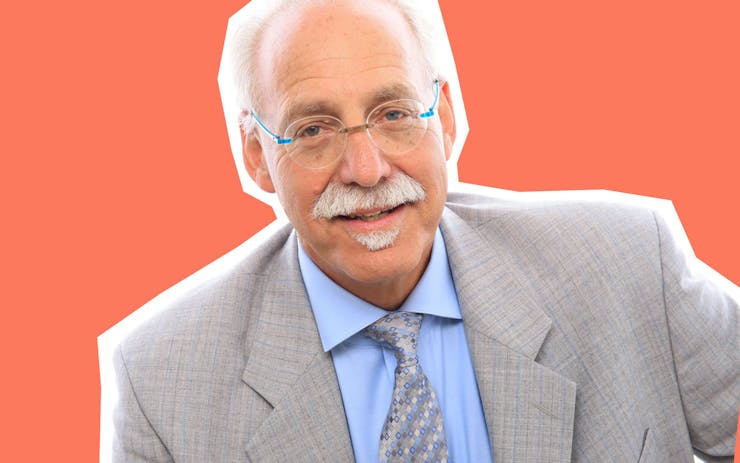The most amazing thing about the progress in cannabis medicine is that most of it is being made by individuals. People are experimenting on themselves to find relief, create products, and discover remedies for a variety of illnesses and diseases. It’s 2019, we can go to the moon, we can create artificial intelligence, but we are still in the dark about the many miracles of medical cannabis.Need Relief? Find Cannabis Near YouUntil the American federal government, through the Drug Enforcement Administration, reclassifies cannabis from its very political Schedule I status, patients, nurses, caregivers, and doctors are very much on their own for information, research, and resources that can help guide their use of medical cannabis treatment. Without consistent regulation and efficient laboratory testing, it can be hard to use medical cannabis right now, though it is finally easier to get in states that have legalized medicinal use.
Dr. Michael H. Moskowitz, MD, MPH has been working in public health and medicine for almost forty years, specializing in researching and writing about neuroplasticity and chronic pain. After experimenting on himself first and then going rogue within his own practice, he compassionately gives his experience and research of medicinal cannabis in the exceptional book, Medical Cannabis: A Guide for Patients, Practitioners, and Caregivers.
Diving into questions and issues everyone has about using cannabis medicinally right now, this book is the best thing available on the market. Dr. Moskowitz delivers the science and the practicality necessary to understand how cannabis works in the brain and the body, and how you can approach using it—whether you’re the doctor or the patient.
Breaking the Stigma Between Doctors and Cannabis Medicine
“I was treating patients for probably thirty years when I came upon this [cannabis] in chronic pain treatment, and what I was impressed with was how muddy all of the medicines we were using were. Even though we got people better, we never got anybody well or rarely got anybody well. The rubric in chronic pain treatment is to tell the patient ‘we can help you reduce your pain but we can’t make it go away.’ I thought, that’s just crap, why are we telling people that? We’re only telling them that because we don’t have the tools that we know how to use to make it go away, but it doesn’t mean they don’t exist,” Dr. Moskowitz explained.
“With cannabis, it was the opposite. People decided this was a medicine that was helpful to some of their issues, doctors kind of thought it was just wink, wink, nudge, nudge, and they were just getting high ... They just looked at it as a reasonable thing for people to do who felt so awful.”
While researching chronic pain treatment, Moskowitz experimented with neuroplastic hypnotherapy treatment. Unfortunately, it didn’t work so well for that particular patient, but it absolutely helped his own chronic neck pain. So he dived deeper into working with visualizations and developed a graphic workbook with animations that proved successful in treating chronic pain. He added, “We’ve developed lotions out of that that treat part of the brain where pain’s really harbored. We brought in salves and vibrations and all kinds of things to counter stimulate the pain signal with other sensory input.”
About five years into this research and treatment, he was asked by the American Academy of Pain Medicine to do a series of talks and lectures around the country on medical cannabis. “As a medical concept, it’s completely backwards from the way we mostly do things where some scientists develop an idea about something and it gets studied, tested on animals, then tested on humans and brought to market, etc. etc. With cannabis, it was the opposite. People decided this was a medicine that was helpful to some of their issues, doctors kind of thought it was just wink, wink, nudge, nudge, and they were just getting high. But these people were in such bad shape it was okay for them, and so doctors really didn’t look at it as a legitimate treatment. They just looked at it as a reasonable thing for people to do who felt so awful.”
Up to this point, doctors would send people to dispensaries and they would talk to people [budtenders] who generally didn’t know anything about medicine. Dr. Moskowitz began gathering his own research and doing lectures on it, despite never trying it as a treatment. This went on for about five more years, the first lecture being in 2011.
“I taught it at a number of places. I’m actually one of the two people I know in the world that’s taught medical cannabis to the federal government. I taught it at Walter Reed Hospital for the 5th Annual Army, Air Force, VA International Chronic Pain meeting,” he said. He still had not used it on himself or any patients.
Healing, Cancer, and Why Whole Plant Medicine Matters
As Moskowitz was teaching and researching, he became impressed with the fact that it looked like cannabis might be a fairly effective treatment for cancer. He experienced problems with his own prostate in the past without it being cancer, but after receiving an MRI that showed he had about a 90% chance of it, along with a high PSA (Prostate-Specific Antigen), his neurologist wanted to biopsy. He asked his doctor if they could wait and watch since it didn’t seem aggressive at that moment, and he wanted to instead treat himself with cannabis for a few years first. His doctor agreed and certified him for medical cannabis use.
“I really researched this out and I did a number of different things on myself. I realized as I was doing this that I was feeling really good, my physical health felt improved after about three months. I ended up continuing to feel really good, my PSA dropped that first year from 9.5, (which is high) to 8.3, which was still high but quite a bit lower. But the next year it jumped up to 13.5, which it’s not absolute that you’ll have prostate cancer, but it’s a pretty good chance you will—they thought 99% sure I had it. I did a biopsy about a year and 8 months into this treatment. I’d been very methodical about this, I treated it very very carefully, and it was negative.”
“Everything we know about CBD as a treatment pretty much came from THC ... we gradually learned a lot more about THCA, CBDA, THCV, CBC, CBDV, CBN, and CBG. There’s this tremendous synergy that makes up that ensemble or entourage effect.”
The day after these results, Dr. Moskowitz broke his ankle and fibula. He had to have 4 surgeries and still, he had never used cannabis for pain. After his first surgery, he used opioids for three days, and it helped a little, but not particularly well. “I started using more cannabis with higher THC because I was doing nothing but laying around at that point and I got great pain relief. I came up with a treatment where I used a combination of THC and CBD in alcohol tincture in a rollerball, rolled around the area where the surgery was because I couldn’t touch it, it was still an open wound, and it took the pain away 100% within three minutes. It never failed to do that, not once.”
Passionate about using the whole plant in his treatments, he began to tap into the ensemble effect of medicinal cannabis. “CBD doesn’t absorb particularly well under the tongue, it’s actually one of the worst places to absorb it into the body, but THC does. Everything we know about CBD as a treatment pretty much came from THC as a recreational drug because that’s all anybody ever looked at. Now, we gradually learned a lot more about CBD but also THCA, CBDA, THCV, CBC, CBDV, CBN, and CBG. There’s this tremendous synergy that makes up that ensemble or entourage effect,” Dr. Moskowitz explained.
With hardware in his leg for several months, Dr. Moskowitz continued applying the rollerball treatment, which lasted 6—8 hours, sometimes longer. Struck by the remarkable qualities he experienced, he wanted to bring this into his own practice. After looking at the law and acknowledging the potential problems, he decided he could not deny it to his patients. “They’re really suffering, and this looks like a really good treatment. When I treated the pain issues with myself, not the prostate, I noticed it didn’t just suppress the symptoms but it healed the tissue—it’s also healing the tissue in the dermis of the skin which then helps heal the tissue below that.”
Shop highly rated dispensaries near you
Showing you dispensaries nearDiscovering New Methods of Treatment With Cannabis
In his own practice in Marin County, California, Dr. Moskowitz asked his patients if they were interested in trying medicinal cannabis. For those who were, he followed them in a separate database to see what it did for their pain, stress, quality of life, sleep, energy and focus. The last two of which he expected were going to be worse. He also considered if they were on opioid medications, if they lowered them.
His book further explains how he worked with his patients, and ultimately, he discovered that cannabis is an infinite treatment. There were so many combinations and permutations that you can never run out of ideas.
Knowing only the THC and CBD content of a strain is limiting; it takes away the blending of the entourage effect and doesn’t help in recommending something based on its medical values.
“I did it [cannabis treatment] over nineteen and a half months, and I followed 161 people. Every time [a patient] came in, I would talk to them about their pain, stress, sleep, quality of life, energy, focus. And if they were on opioids, did they lower their opioids? At the end, 87% of the patients reported pain reduction, 81% reported improved sleep, 73% improved stress, and 76% improved quality of life. Those are remarkable numbers in a practice like mine. We get tough cases and we work them for years and years and years, so I really know these people. It’s not like a typical study where you’re getting randomized strangers from out in the world. These are my patients, and I know them pretty well. It also brings in a little bias in their results because they want to please me, but I’ve done many of these things with neuroplasty over the years and I never saw such a robust response.”
Other results included 53% reporting improved energy and only 7% worse energy. 43% reported improved focus and only 8% worse focus. They weren’t stopping their other medications, just adding this treatment and then adjusting whatever needed adjusted. 71.3% of patients reduced their opioids and 14% came off of them completely.
The ensemble effect that Dr. Moskowitz has tapped is there for a reason. In the plant, it’s there to help the plant survive in nature, but the doctor is quick to point out that over the last 30,000 years, humans have moved the plant from the three isolated places it existed in the world (Asia, sub-Saharan Africa, and equatorial South America). “We’ve planted this in closets, desert, in rocks, in water, and in the air. We’ve done all kinds of things with it and we’ve totally changed the genetics of the plant. We’ve also used it in mass quantities. We’ve really passed these genes to most of the population, so most people have adapted to this plant even though they’ve never had it,” he said. Another reason why this is important is because it faults animal studies. Humans have a unique interaction with cannabis , no rat or dog or monkey has adapted to cannabis over the last 30,000 years.
As more dispensaries open and have quality medicinal products available, we should request they begin to give more information on their labels. Knowing only the THC and CBD content of a strain is limiting; it takes away the blending of the entourage effect and doesn’t help in recommending something based on its medical values.
When purchasing medicine, not only is strain knowledge important (beyond “sativa” and “indica”) but also the embodiment of the way they’re manufactured, whether it’s tinctures, capsules, vaporizers, etc. New laws in different states are emerging to make testing imperative, but the lack of consistency in testing itself is still an issue. Dr. Moskowitz added that it would be beneficial if at least nine cannabinoids were covered in the testing and available on the labeling. With so much more to discover in this early phase of cannabis research, his book is a fantastic and easily accessible guide into everything you need to know about using medicinal cannabis today.







